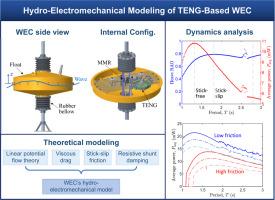基于teng的波浪能转换器的水力-机电建模
IF 9.4
1区 工程技术
Q1 ENGINEERING, MECHANICAL
International Journal of Mechanical Sciences
Pub Date : 2025-09-11
DOI:10.1016/j.ijmecsci.2025.110828
引用次数: 0
摘要
可靠且具有成本效益的自供电海洋监测浮标对于海洋物联网的发展至关重要。现有的太阳能系统面临着能源可用性的限制和大规模应用的高成本。这项工作提出了一种基于摩擦电纳米发电机的波浪能转换器,它利用海浪来发电。该装置结合了一个起伏点吸收器、一个机械运动整流器和一个旋转摩擦电纳米发电机,可以在不同的波浪条件下实现一致的功率输出。我们建立了一个综合的水力机电模型,包括粘性阻力,粘滑摩擦和电阻并联阻尼,并使用混合频域和时域方法分析非线性动力学。结果表明,摩擦引起的粘滑运动强烈影响性能,能量输出在两个宽间隔的波周期达到峰值。优化摩擦学扇区数,摩擦力和传动比提高了功率输出和操作平稳性。这些发现为设计成本效益高、效率高、重量轻的海洋监测海浪动力系统提供了重要见解。本文章由计算机程序翻译,如有差异,请以英文原文为准。

Hydro-electromechanical modeling of TENG-based wave energy converter
Reliable and cost-effective self-powered marine monitoring buoys are essential for the advancement of the marine Internet of Things. Existing solar-powered systems face limitations in energy availability and high costs for large-scale applications. This work presents a triboelectric nanogenerator-based wave energy converter that harnesses ocean waves to generate electricity. The device combines a heaving point absorber, a mechanical motion rectifier, and a rotary triboelectric nanogenerator, enabling consistent power output under varying wave conditions. We develop a comprehensive hydro-electromechanical model incorporating viscous drag, stick-slip friction, and resistive shunt damping, and analyze the nonlinear dynamics using a hybrid frequency- and time-domain approach. Results reveal that friction-induced stick-slip motion strongly influences performance, with energy output peaking at two widely spaced wave periods. Optimizing triboelectric sector number, friction, and gear ratio improves both power output and operation smoothness. These findings provide critical insights into the design of cost-effective, efficient, and lightweight wave-powered systems for marine monitoring applications.
求助全文
通过发布文献求助,成功后即可免费获取论文全文。
去求助
来源期刊

International Journal of Mechanical Sciences
工程技术-工程:机械
CiteScore
12.80
自引率
17.80%
发文量
769
审稿时长
19 days
期刊介绍:
The International Journal of Mechanical Sciences (IJMS) serves as a global platform for the publication and dissemination of original research that contributes to a deeper scientific understanding of the fundamental disciplines within mechanical, civil, and material engineering.
The primary focus of IJMS is to showcase innovative and ground-breaking work that utilizes analytical and computational modeling techniques, such as Finite Element Method (FEM), Boundary Element Method (BEM), and mesh-free methods, among others. These modeling methods are applied to diverse fields including rigid-body mechanics (e.g., dynamics, vibration, stability), structural mechanics, metal forming, advanced materials (e.g., metals, composites, cellular, smart) behavior and applications, impact mechanics, strain localization, and other nonlinear effects (e.g., large deflections, plasticity, fracture).
Additionally, IJMS covers the realms of fluid mechanics (both external and internal flows), tribology, thermodynamics, and materials processing. These subjects collectively form the core of the journal's content.
In summary, IJMS provides a prestigious platform for researchers to present their original contributions, shedding light on analytical and computational modeling methods in various areas of mechanical engineering, as well as exploring the behavior and application of advanced materials, fluid mechanics, thermodynamics, and materials processing.
 求助内容:
求助内容: 应助结果提醒方式:
应助结果提醒方式:


